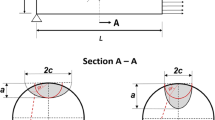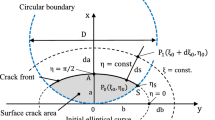Abstract
Experimental backtracking technique and finite element analysis have been employed to evaluate the stress intensities along the front of an elliptical surface crack in a cylindrical rod. The finite element solution covers a wide range of crack shapes loaded under end-free and end-constrained axial tension and pure bending. Convenient closed form stress intensity expressions along the whole crack front for each of the loading cases have been given in terms of the crack aspect ratio, crack depth ratio and place ratio.
The closed form solutions have been compared against a number of representative solutions collected from the literature. It has been found that different finite element results for the interior points are generally in good mutual agreement, while solutions derived from other methods may sometimes indicate different trends. At the surface interception point agreement is less good because of a complication in the interpretation of stress intensity there.
Experimental backtracking results on the end-constrained axial tension case corroborate well with the closed form solution presented. It suggests that the current closed form solution is adequate in describing the stress intensities along the whole crack front of real surface cracks in cylindrical rods.
Similar content being viewed by others
References
Astiz, M.A. (1986). An incompatible singular elastic element for two-and three-dimensional crack problems. International Journal of Fracture 31, 105–124.
Athanassiadis, Boissenot, J.M., Brevet, P., Francois, D. and Raharinaivo, A. (1981). Linear elastic fracture mechanics computations of cracked cylindrical tensioned bodies. International Journal of Fracture 17, 553–566.
Barsoum, R.S. (1976). On the use of isoparametric finite element s in linear fracture mechanics. International Journal for Numerical Methods in Engineering 10, 25–37.
Bazant, Z.P. and Estenssoro, L.F. (1979). Surface singularity and crack propagation. International Journal of Solids and Structures 15, 405–426.
Bush, J. (1976). Experimentally determined stress-intensity factors for single-edge-crack round bars loaded in bending. Experimental Mechanics 249–257.
Bush, J. (1981). Stress intensity factors for single-edge-crack solid and hollow round bars loaded in tension. Journal of Testing and Evaluation 9, 216–223.
Cai, C.Q. and Shin, C.S. (2004a). 'A discussion on "The stress intensity factor study of an elliptical cracked shaft' by Y.S. Shih and J.J. Chen, Nuclear Engineering and Design 227(3), 355–358.
Cai, C.Q. and Shin, C.S. (2004b). A normalized area-compliance method for monitoring the surface crack development in a cylindrical rod. unpublished results.
Carpinteri, A. (1992a). Stress intensity factors for straight-fronted edge cracks in round bars. Engineering Fracture Mechanics 42, 1035–1040.
Carpinteri, A. (1992b). Elliptical-arc surface cracks in round bars. Fatigue and Fracture of Engineering Materials and Structures 15, 1141–1153.
Carpinteri, A. and Brighenti, R. (1996). Part-through cracks in round bars under cyclic combined axial and bending loading. International Journal of Fatigue 18, 33–39.
Caspers, M., Mattheck, C. and Munz, D. (1990). Propagation of surface cracks in notched and unnotched rods. Surface-Crack Growth: Models, Experiments, and Structures ASTM STP 1060, 365–389.
Couroneau, N. and Royer, J. (1998). Simplified model for the fatigue growth analysis of surface cracks in round bars under mode I. International Journal of Fatigue 10, 711–718.
Daoud, O.E.K., Cartwright, D.J. and Carney, M. (1978). Strain-energy release rate for a single edge-cracked circular bar in tension. Journal of Strain Analysis 13, 83–89.
Daoud, O.E.K. and Cartwright, D.J. (1985). Strain energy release rate for a circular-arc edge crack in a bar under tension or bending. Journal of Strain Analysis 20, 53–58
Dawicke, D.S., Grandt, Jr., A.F. and Newman Jr, J.C. (1990). Three-dimensional crack closure behavior. Engineering Fracture Mechanics 36, 111–121.
Fleck, N.A., Smith, I.F.C. and Smith, R.A. (1983). Closure behaviour of surface cracks, Fatigue and Fracture of Engineering Materials and Structures 3, 225–239.
Fleck, N.A. (1988). Influence of stress state on crack growth retardation. Basic Questions in Fatigue ASTM STP 924, 157–183.
Forman, R.G. and Shivakumar, V. (1986). Growth behavior of surface cracks in the circumferential plane of solid and hollow cylinders. Fracture Mechanics: Seventeen volume. ASTM 905, 59–74.
Hayashi, K. and Abe, H. (1980). Stress intensity factors for a semi-elliptical crack in the surface of a semi-infinite solid. International Journal of Fracture 16, 275–285.
Hellen, T.K. (1975). On the method of virtual crack extension. International Journal for Numerical methods in Engineering 9, 187–207.
James, L.A. and Anderson, W.E. (1969). A Simple Experimental procedure for Stress Intensity Calibration. Engineering Fracture Mechanics 1, 565.
Lorentzen, T., Kjaer, N.E. and Henriksen, T.K. (1986). The application of fracture mechanics to surface cracks in shafts. Engineering Fracture Mechanics 23, 1005–1014.
Mackay, T.L. and Alperin, B.J. (1985). Stress intensity factors for fatigue cracking in high-strength bolts. Engineering Fracture Mechanics 21, 391–397.
Murakami, Y. and Tsuru, H. (1987). Stress-Intensity factor equations for semi-elliptical surface crack in a shaft under bending. Stress Intensity Factors Handbook, Vol II. Oxford: Pergamon Press 657–658.
Nord, K.J. and Chung, T.J. (1986). Fracture and surface flaws in smooth and threaded round bars. International Journal of Fracture 30, 47–55.
Parks, D.M. (1974). A stiffness derivative finite element technique for determination of elastic crack tip stress intensity factor. International Journal of Fracture 10, 487–502.
Raju, I.S. and Newman, J.C. (1986). Stress-intensity Factors for circumferential surface cracks in pipes and rods under tension and bending loads. Fracture Mechanics: Seventeen volume. ASTM STP 905, 789–805.
Ray, S.K., Perez, R. and Grandt, Jr., A.F. (1987). Fatigue Crack Closure of Corner Cracks Located at Holes Loaded in Tension or Bending. Fatigue and Fracture of Engineering Materials and Structures 10, 239–250.
Schijve, J. (1985). Comparison Between Empirical and Calculated Stress Intensity Factors of Hole Edge cracks. Engineering Fracture Mechanics 22, 49–58.
Shih, Y.S. and Chen, J.J. (2002). The stress intensity factor study of an elliptical cracked shaft. Nuclear Engineering and Design 214, 137–145.
Shin, C.S. (1990). The stress intensity factors of corner cracks emanating from holes. Engineering Fracture Mechanics 37, 423–436.
Shin, C.S. and Chen, P.C. (2004). Fatigue crack propagation testing using subsized rotating bending specimens. In press in Nuclear Engineering and design.
Shiratori, M., Miyoshi, T., Sakai, Y. and Zhang, G.R. (1986). Analysis of stress intensity factors for surface cracks subjected to arbitrarily distributed surface stresses. Trans. Japan Soc. Mech. Engrs. 660–662.
Troha, W.A., Nicholas, T. and Grandt, Jr, A.F. (1988). Three dimensional aspects of fatigue crack closure in surface flaws in polymethylmethacrylate material. ASTM STP 982, 598–616.
Wilhem, D., FitzGerald, J., Carter, J. and Dittmer, D. (1982). An empirical approach to determining K for surface cracks. Proceedings of the 5 th international Conference on Fracture Research 11–21.
Author information
Authors and Affiliations
Rights and permissions
About this article
Cite this article
Shin, C., Cai, C. Experimental and finite element analyses on stress intensity factors of an elliptical surface crack in a circular shaft under tension and bending. International Journal of Fracture 129, 239–264 (2004). https://doi.org/10.1023/B:FRAC.0000047784.23236.7d
Issue Date:
DOI: https://doi.org/10.1023/B:FRAC.0000047784.23236.7d




